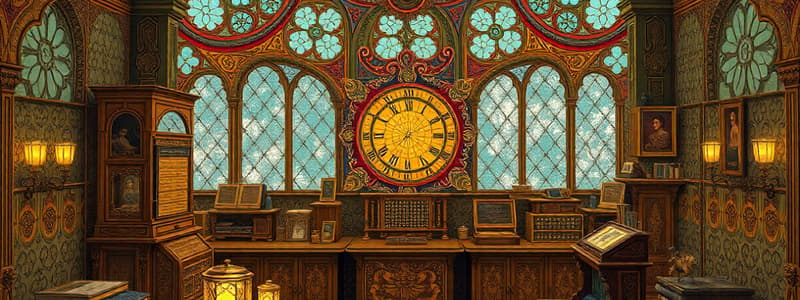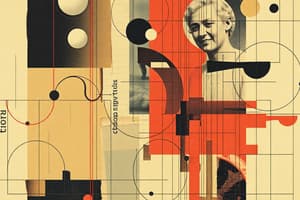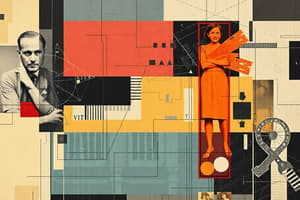Podcast
Questions and Answers
How does a transfer function represent the dynamic behavior of a control system?
How does a transfer function represent the dynamic behavior of a control system?
A transfer function represents the dynamic behavior of a control system as a ratio of polynomials that relates the input signal to the output signal.
What is the significance of frequency response analysis in transfer functions?
What is the significance of frequency response analysis in transfer functions?
Frequency response analysis in transfer functions reveals how the system reacts to different input frequencies, which is vital for predicting stability and performance.
Identify two critical performance factors to consider when evaluating sensors in a control system.
Identify two critical performance factors to consider when evaluating sensors in a control system.
Accuracy and response time are two critical performance factors to consider when evaluating sensors.
What role do actuators play in a control system?
What role do actuators play in a control system?
What is the primary function of negative feedback systems in control applications?
What is the primary function of negative feedback systems in control applications?
Explain the purpose of feedback loops in closed-loop control systems.
Explain the purpose of feedback loops in closed-loop control systems.
In what scenario would a positive feedback loop be preferred over a negative feedback loop?
In what scenario would a positive feedback loop be preferred over a negative feedback loop?
Describe the role of a controller in a feedback loop system.
Describe the role of a controller in a feedback loop system.
How can multiple transfer functions be utilized in complex control systems?
How can multiple transfer functions be utilized in complex control systems?
Why is calibration important for sensors in control systems?
Why is calibration important for sensors in control systems?
What distinguishes a PID controller from proportional, integral, and derivative controllers?
What distinguishes a PID controller from proportional, integral, and derivative controllers?
How do instances of accumulated errors influence the design of an integral controller?
How do instances of accumulated errors influence the design of an integral controller?
What factors influence the choice of an actuator in a control system?
What factors influence the choice of an actuator in a control system?
Why is tuning the parameters of a PID controller critical in control systems?
Why is tuning the parameters of a PID controller critical in control systems?
Describe how error signals are generated in feedback-controlled systems.
Describe how error signals are generated in feedback-controlled systems.
In what ways do sensor noise and drift affect the operation of a control system?
In what ways do sensor noise and drift affect the operation of a control system?
What is the significance of using digital signal processing in modern controllers?
What is the significance of using digital signal processing in modern controllers?
Explain how derivative controllers anticipate errors in a control system.
Explain how derivative controllers anticipate errors in a control system.
What types of systems typically require the implementation of feedback loops?
What types of systems typically require the implementation of feedback loops?
How do sensors play a role in feedback loop systems?
How do sensors play a role in feedback loop systems?
Flashcards
Control System
Control System
A set of components working together to achieve a desired output.
Transfer Function
Transfer Function
Describes input-output relationship in a system.
Sensor
Sensor
Measures physical parameters, like temperature or position.
Actuator
Actuator
Signup and view all the flashcards
Feedback Loop
Feedback Loop
Signup and view all the flashcards
Closed-Loop Control
Closed-Loop Control
Signup and view all the flashcards
Sensor noise
Sensor noise
Signup and view all the flashcards
Setpoint
Setpoint
Signup and view all the flashcards
Error signal
Error signal
Signup and view all the flashcards
Controller
Controller
Signup and view all the flashcards
Negative feedback
Negative feedback
Signup and view all the flashcards
Positive feedback
Positive feedback
Signup and view all the flashcards
Proportional controller (P)
Proportional controller (P)
Signup and view all the flashcards
Integral controller (I)
Integral controller (I)
Signup and view all the flashcards
Derivative controller (D)
Derivative controller (D)
Signup and view all the flashcards
PID controller
PID controller
Signup and view all the flashcards
Controller parameter tuning
Controller parameter tuning
Signup and view all the flashcards
Digital signal processing (DSP)
Digital signal processing (DSP)
Signup and view all the flashcards
Study Notes
Control System Components
- A control system is a set of interconnected components that work together to achieve a desired output. These components include sensors, actuators, feedback loops, and controllers.
Transfer Functions
- A transfer function mathematically describes the relationship between the input and output of a system. It's particularly useful in analyzing and designing control systems.
- Transfer functions are typically expressed as a ratio of polynomials, representing the system's dynamic behavior.
- The transfer function's frequency response analysis reveals how the system responds to different input frequencies. This analysis aids in predicting system stability and performance.
- Transfer functions can be derived from a system's differential equations or block diagrams.
- Complex systems may utilize multiple transfer functions, interconnected to represent their component behaviors.
Sensors
- Sensors are devices that detect and measure physical parameters, such as temperature, pressure, or position.
- Types of sensors include thermocouples for temperature, pressure transducers, and potentiometers for position measurement.
- Sensor performance is critical; factors to consider include accuracy, range, response time, and sensitivity.
- Ideally, sensors provide accurate, reliable, and timely data for feedback in the control system.
- Sensor noise and drift are key concerns that can impact the system. Calibration is a critical step in accurate measurement.
Actuators
- Actuators are components that convert control signals into physical actions. These can be mechanical (motors, solenoids), hydraulic, pneumatic, or electronic (e.g., transistors switching a voltage source).
- Examples include motors in robotic arms, valves controlling fluid flow, and relays regulating electrical signals.
- Actuator characteristics such as speed, torque, force, and power output are vital to system performance.
- The choice of actuator depends on the load and task requirements. Energy efficiency and output constraints are often important factors.
Feedback Loops
- Feedback loops provide a means to compare the system's actual output to its desired output (setpoint).
- Closed-loop control systems use feedback to adjust actuator input based on the difference between setpoint and actual output.
- This comparison generates an error signal used by the controller to make corrective actions.
- Feedback loops minimize disturbances, maintain stable performance, and enhance accuracy.
- Negative feedback systems, where the error signal opposes the disturbance, are vital in many control applications.
- Positive feedback loops, though less common, can amplify or accelerate a system's response. These may be useful in systems where triggering a reaction is required.
Controllers
- Controllers are algorithms and/or devices that process the error signal and adjust the actuator input.
- Common controller types include proportional (P), integral (I), derivative (D), PID (a combination of P, I, and D) controllers.
- P controllers react to the current error, I controllers account for accumulated errors over time to compensate for steady-state errors, and D controllers anticipate errors based on the rate of change in the error.
- PID controllers are often the most sophisticated choice, offering superior performance and robustness in many control systems.
- The controller's parameters (e.g., gain values in PID) must be tuned to achieve the desired system performance.
- Modern controllers often involve digital signal processing for real-time calculations and increased complexity.
Studying That Suits You
Use AI to generate personalized quizzes and flashcards to suit your learning preferences.




